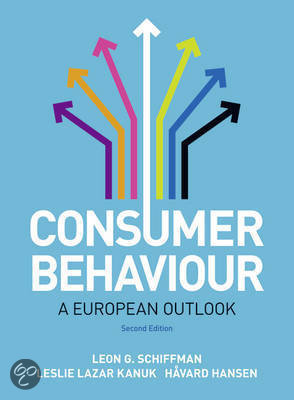INDUSTRIAL PSYCHOLOGY 224
(CONSUMER PSYCHOLOGY)
CHAPTERS 8-16
1
,CHAPTER 8: CONSUMER ATTITUDE FORMATION & CHANGE
WHAT ARE ATTITUDES
Attitude: a learned predisposition to behave in a consistently favourable or
unfavourable way with respect to a given object
o Each part of this definition describes an important property of an attitude & is
critical to understanding the role of attitudes in consumer behaviour
THE ATTITUDE OBJECT
The word ‘object’ in our consumer-oriented definition of attitude should be interpreted
broadly to include specific consumption- or marketing-related concepts, i.e. product,
product category, brand, service, possessions, product use, causes or issues, people,
adverts, internet site, price, medium or retailer
Attitude can be conceptualised as a summary evaluation of an object
ATTITUDES ARE A LEARNED PREDISPOSITION
Attitudes are learned
Attitudes relevant to purchase behaviour are formed as a result of:
o direct experience with the product,
o word-of-mouth information acquired from others, or
o exposure to mass-media advertising, the internet, social media
o exposure to direct marketing, i.e. newspapers & magazine inserts, and retailer’s
catalogues
although attitudes may result from behaviour, they are not synonymous with behaviour
o instead they reflect either a favourable or an unfavourable evaluation of the attitude
object
o as learned predispositions, attitudes have a motivational quality they might
propel a customer toward a particular behaviour or repel the consumer from a
particular behaviour
ATTITUDES HAVE CONSISTENCY
Attitudes are relatively consistent with the behaviour they reflect
However, despite their consistency, attitudes are not necessarily permanent; they do
change
Normally we expect consumers’ behaviour to correspond with their attitudes
o When consumers are free to act as they wish, we anticipate that their actions will be
consistent with their attitudes
o However, circumstances often prelude consistency between attitudes & behaviour
o Therefore, we must consider possible situational influences on consumer attitude
Attitudes occur within a situation
A specific situation can cause consumers to behave in ways seemingly inconsistent with
their attitudes
Consumers can have a variety of attitudes toward a particular object, each
corresponding to a particular situation or application
It is important to understand how consumer attitudes vary from situation to situation
2
,STRUCTURAL MODELS OF ATTITUDES
Motivated by a desire to understand the relationship between attitudes & behaviour,
psychologists have south to construct models that capture the underlying dimensions of
an attitude
Several NB attitude models:
o The tri-component model
o The multi-attribute attitude model
o The trying-to-consume model
o The attitude-toward-the-ad-model
TRI COMPONENT ATTITUDE MODEL
Attitude consists of 3 major components
1. Cognitive component
o Consists of a person’s cognitions – the knowledge & perceptions that are
acquired by a combination of direct experience with the attitude object & related
information from various sources
o This knowledge & perceptions commonly take the form of beliefs – i.e. the
consumer believes the attitude object possesses various attributes & that
specific behaviour will lead to specific outcomes
2. Affective component
o A consumer’s emotions or feelings about a particular product or brand constitute
the affective component of an attitude
3. Conative component
o Is concerned with the likelihood or tendency that an individual will undertake a
specific action or behave in a particular way with regard to the attitude object
MULTI-ATTIRUBTE ATTITUDE MODELS
Multi-attribute attitude models portray consumers’ attitudes with regards to an attitude
object (e.g. a product, service, cause or issue) as a function of consumers’ perception &
3
, assessment of the key attributes or beliefs held with regard to the particular attitude
object
There are 3 models to consider:
1. The attitude-toward-object model
o For measuring attitudes toward a product or service category or specific brands
o Consumers attitude towards a product or specific brands of a product is a function of
the presence (or absence) & evaluation of certain product-specific brands
2. The attitude-toward-behaviour model
o Designed to capture the individual’s attitude toward behaving or acting with respect
to an object rather than the attitude toward the object itself
o Corresponds closely to actual behaviour
3. The theory-of-reasoned-action model (TRA)
o Represents a comprehensive integration of attitude components into a structure
that is designed to lead to both better explanation & predications of behaviour
o Incorporates a cognitive component, an affective component & a conative
component
o Includes subjective norms in addition to attitude
THE THEORY OF TRYING-TO-CONSUME MODEL
Designed to account for the many cases in which the action or outcome is not certain
but instead reflects the consumer’s attempts to consume (i.e. purchase)
Environment or personal factors may hinder it
4
, ATTITUDE-TOWARD-THE-AD MODELS
A consumer forms various feelings (affects) & judgements (cognitions) as the result of
exposure to an advertisement
These feelings & judgements in turn affect the consumer’s attitude toward the ad &
beliefs about the brand secured from exposure to the advert
The consumer’s attitude toward the advert & beliefs about the brand influence their
attitude toward the brand
ATTITUDE FORMATION
Examination of attitude formation is divided into 3 areas:
1. How attitudes are learned
2. The sources of influence on attitude formation
3. The impact of personality on attitude formation
HOW ATTITUDE IS LEARNED
The formation of attitude refers to the shift from having no attitude toward a given
object, to having some attitude toward it
The shift from no attitude to an attitude (i.e. attitude formation) is a result of learning
Consumers often purchase new products that are associated with a favourably viewed
brand name
o Their favourable attitude toward the brand name is frequently the result of repeated
satisfaction with other products produced by the same company
o Ito classical conditioning, an established brand, would be the conditioned stimulus
Sometimes attitudes follow the purchase & consumption of a product
5





